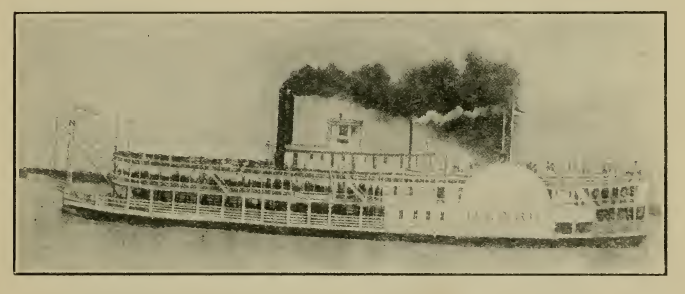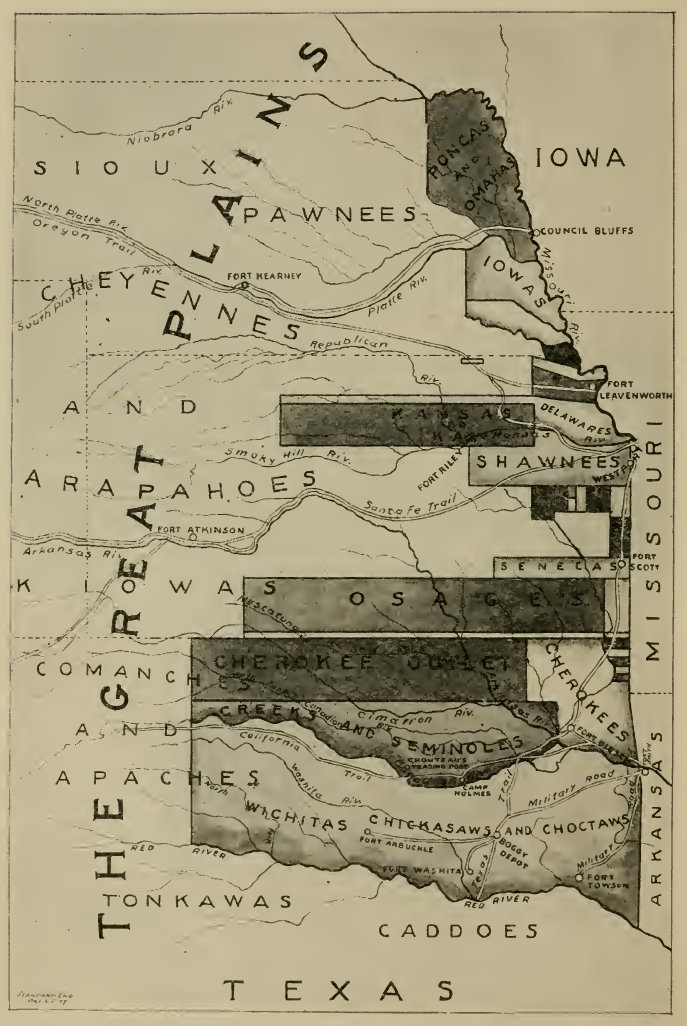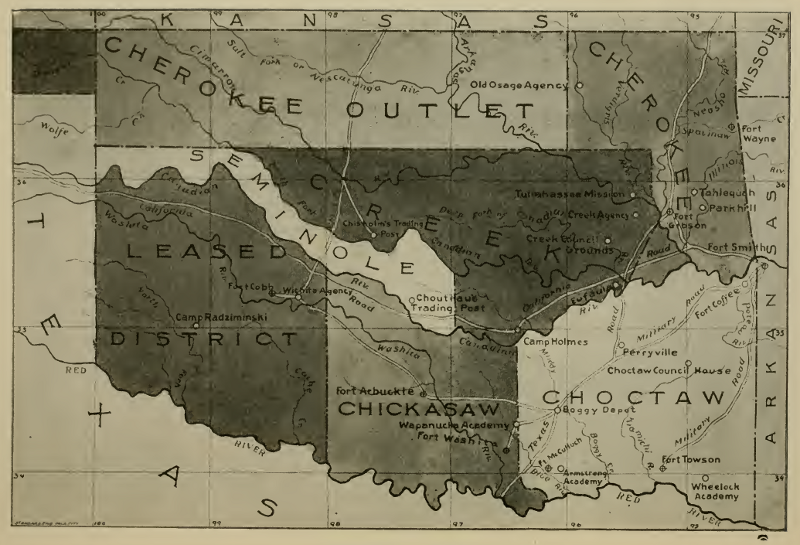| FOURTH PERIOD |
| (1840-1860) |
| AN ERA OF PEACEFUL DEVELOPEMENT. |
| The Great Floods of 1844.— The year of 1844 was a memorable one in the Indian Territory as elsewhere throughout the West on account of the great floods which prevailed. In addition to the annual “June rise,” which was due to the melting of snow in the mountains about the sources of the rivers, there was a season of unusual rainfall throughout the region of the Great Plains. All of the rivers in the Indian Territory overflowed their banks, causing great destruction of property and some loss of life. |
| Overland Trade and Travel. —During the summer of 1850, Lieut. J. H. Simpson surveyed and laid out a road from east to west across Oklahoma. From the Arkansas River the road followed the north bank of the Canadian to a point near Chouteau’s trading post, in what is now the southern part of Cleveland County. Thence it followed the south bank of the Canadian to a point in the northern part of Caddo county, whence it crossed over to the valley of the Washita. After following the valley of that stream for some distance it re-entered the Canadian valley in Roger Mills County. Another overland trail, known as the Texas Road, came to be much used for travel and freighting during this period. Originally it was part of a military road leading from Fort Scott (Kansas) to Fort Gibson. From Fort Gibson to the Red River it followed the trail which was first marked out by the Leavenworth expedition in 1834, passing through Boggy Depot. |
| Indian Trade. —Trade among the Indians of the civilized tribes was not greatly unlike that of the country merchant of that period in other parts of the country. Trade among the Indians of the wild tribes of the Plains was a profitable business, although there was often much risk in it. |
| Growth of Slavery. —With the increase of wealth among the Indians of the civilized tribes, the owning of negro slaves also increased. Most of the slave owners in the Indian Territory were Indians of the mixed-blood class. Some of these owned large plantations upon which many slaves were worked. |
| The Texas Cession. —On November 25, 1850, the state of Texas withdrew its claim to the ownership of lands lying north of 36° 30’ north latitude. The tract which thus became a part of the public domain of the United States included the counties of Beaver, Cimarron and Texas in the state of Oklahoma. |
| River Navigation. —During this period, steamboat navigation on the Mississippi River and its principal tributaries was largely used for both trade and trwel. The merchants and traders of the Indian Territory made use of steamboats in shipping in goods and supplies and also in shipping out the products of the country which they handled. Some of the big steamboats from the lower Mississippi used to come up the Arkansas as far as Skullaville and Fort Gibson. Steamboats also navigated the Red River at certain seasons of the year as far up as the mouth of the Washita, a great deal of cotton being shipped to New Orleans in that way. |
| At the Steamboat Landing. |
The arrival of a steamboat at Fort Gibson, or Skullaville, in olden times was always an important event in the life of the community. The sound of the whistle of the approaching vessel was a signal which was sure to cause an immediate gathering of the major portion of the inhabitants at the landing on the river bank. The negro deck hands were soon busied in unloading the cargo. Before long the landing would be covered with piles of freight for the merchants and traders and with great quantities of stores for the Government military posts and Indian agencies. Meanwhile many Indians of the Cherokee, Creek, Osage and other tribes would line the shore, most of them staring in wonder at the great "fire-canoe." At such times the engineers found great sport in blowing off the mud-valve with its loud roar, whereupon the crowd would run away from the boat.
The cargo for the down-stream voyage sometimes included beef hides, casks of tallow and bags of corn, but almost always there would be great bales of buffalo robes and deer skins and furs, together with barrels and sugar hogsheads filled with pecans. Finally, when the craft was ready for its return voyage, some of the merchants and traders, who had been waiting for the arrival of “a good boat,” would go aboard, followed by servants or employes carrying powder kegs or ax-boxes, filled with Mexican silver dollars, thus prepared for a journey to Memphis, New Orleans, St. Louis or Cincinnati, where they planned to purchase new stocks of goods for their trade. Then, when the boat’s bell clanged and the gangplank was raised and the reversed engines would start the paddle-wheels, the big craft would slowly back out into the channel, while the negro deck hands (who always sang at their work) would give voice to the wild chant of “Far’ yo’ well, Miss Lucy,” and soon the steamboat would disappear around the bend of the river, leaving the little outpost to resume its wonted isolation and loneliness. |
 |
| RIVER STEAMBOAT OF TYPE IN USE IN 1850-60 |
| Besides the steamboats, keelboats and canoes, there was an occasional flatboat to be seen on the Arkansas. These were generally from Southwestern Missouri, where they were built, loaded with bacon, hides, ginseng, sarsaparilla, snakeroot and other pioneer commodities and products, then floated down the Cowskin to the Neosho (or Grand) and thence down to the Arkansas and Mississippi, where a market would be found for both boat and cargo, the crew returning home overland. Some of the Creek and Seminole Indians used to reach the outside world with such surplus products as dried peaches, beans, pecans, gopher peas, rice, etc., in large “dug-out” canoes, each made of a single cottonwood log of mammoth proportions, in which they floated down the Canadian to the Arkansas. Some of these canoes were of sufficient size to hold large barrels laid lengthwise. |
| Exploring Expeditions. —The wilderness of Central and Western Oklahoma still continued to be explored at rare intervals. In 1843, Capt. Nathan Boone, First U. S. Dragoons, commanded an expedition which explored the valleys of the Arkansas, Cimarron and Salt Fork (Nescatunga), in Northern Oklahoma and on northward into Southern and Central Kansas. In 1845, Lieut. James J. Abert explored the valleys of the Canadian and Washita rivers in the extreme western part of Oklahoma. In the spring and summer of 1852, the sources of the Red River were explored by an expedition under the command of Capt. Randolph B. Marcy. |
 |
| THE INDIAN TERRITORY. 1835-1854 |
| The Indian Territory Reduced in Size. —In May, 1854, Congress passed an act providing for the organization of the territories of Kansas and Nebraska. These two territories were formed from parts of what had been known for nearly twenty-five years as the Indian Territory. The Indian Territory, proper, was thus reduced to the area which it included up to the passage of the Organic Act under which Oklahoma Territory was organized in 1890. The Kansas-Nebraska Act fixed the 37th parallel of north latitude as the boundary between Kansas Territory and the Indian Territory. |
| Indians in Kansas Territory. —Although Kansas was thus cut off from the Indian Territory, it contained the reservations of nearly twenty tribes of Indians, besides which there were several tribes of wild Indians of the Plains in the western part of the new territory. Eventually nearly all of these tribes were removed to Oklahoma, though not until after the close of the Civil War. |
| The Northern Boundary Surveyed. —The boundary line between Kansas and the Indian Territory was surveyed in the summer of 1858, by a party under the command of Lieut. Col. Joseph E. Johnston, of the Second U. S. Dragoons. Colonel Johnston afterward became one of the most distinguished generals in the Confederate Army. |
Tribal Changes. —When the Chickasaws came west they joined the Choctaws and purchased an interest in the Choctaw reservation. For many years, they were also under the same tribal government and were supposed to have equal rights and privileges with the Choctaws. This arrangement was somewhat irksome to the Chickasaws because they were always out-numbered and out-voted. The Choctaws were therefore always in full control of the tribal government and only Choctaws were elected to office. The Chickasaws finally insisted upon separating from the Choctaws and they were permitted to do so upon payment of $150,000 to the Choctaws, in 1855.
When the Seminoles first moved west from Florida, in 1845, they joined their relatives, the Creeks. Although they were given the right of full citizenship in the Creek Nation, the Seminoles were not satisfied. Like the Chickasaws, they preferred to govern themselves rather than be governed by the stronger tribe with whom they lived. In August, 1856, the Creeks and Seminoles made a treaty with the Government in which it was provided that a part of the Creek reservation should be set aside for the ownership and use of the Seminoles alone. |

OKLAHOMA, 1856-1866 |
The Choctaws and Chickasaws having separated as the result of the agreement of 1855, both nations adopted new constitutions in 1857. The Choctaw Nation afterward adopted a considerable portion of the statutes of the state of Mississippi as their own laws. After the laws of the Chickasaw Nation had been adopted by the tribal legislature under the new constitution, a young man, who was a member of the tribe, was sent into Texas with the original copies (no duplicates being retained), for the purpose of having them printed. The young man who had been entrusted with this important mission mysteriously disappeared and the laws with him. As a result it became necessary to convene the tribal legislature in special session for the purpose of re-enacting the laws thus lost.
The reservation which was set aside for the Seminoles was bounded on the east by a line which would divide the present county of Pottawatomie into two very nearly equal parts. Thence it extended westward and northwestward to the Texas line, bounded on the south by the Canadian river and on the north by the North Canadian and the Cherokee Outlet. |
| Indian Wars.— The Comanche and Kiowa Indians of Western Oklahoma were at war with the whites much of the time during this period. Most of their raids were directed against the frontier settlements of Texas and the overland emigrant and freighting trains on the Santa Fe Trail. Peace councils were held and treaties were made from time to time but peace seldom lasted long. In these peace councils, the Indians of the civilized tribes often took part, trying to induce the wild Indians to quit the warpath and live on friendly terms with the whites and other Indian tribes. |
 |
| OLD CHICKASAW CAPITOL AND LEGISLATIVE COUNCIL (Built in 1856) |
| Life Among the Civilized Tribes.— The lives led by the people of the Cherokee, Chickasaw, Choctaw, Creek and Seminole tribes during the period between the time they became settled in their new homes in the Indian Territory and the outbreak of the Civil War w^ere simple, care free and happy. Their wants and needs were few and these were easily supplied. They lived at peace with the Government and with each other. The work of the patient and self-sacrificing missionaries among them was meeting with success. The neighborhood school as well as the national or tribal academy and seminary was doing its part to help them in the way of civilization. In many Indian homes there was real refinement. Not a few of the young men and women were sent to the colleges and seminaries in the eastern states to finish their education and training for life. There was not a railroad nearer than the Mississippi and Missouri rivers. All communication with the outside world was by river steamboat, wagon train and stage coach. It was amid such surroundings that the Indians were slowly but surely making progress in the ways of knowledge, skill and enterprise and in the accumulation of wealth. |
| Indian Tribes Settled on the Washita. —Late in the summer of 1859 a number of small tribes and bands of Indians, which had been living on two reservations on the Brazos River in Texas, were removed to the Indian Territory and settled in the valley of the Washita River, within the limits of what is now Caddo County, Oklahoma. These tribes (which included the Caddoes, Keechis, Wacoes, Anadarkoes, Tonkawas, Absentee Shawnees, a small band of Delawares and the Peneteka Comanches) left Texas to avoid a war of extermination. Shortly after they arrived at their new reservation on the Washita, they were joined by the Wichitas, who formerly lived in the Wichita Mountains. |
| New Military Posts. —The military posts established in the Indian Territory during this period were Fort Washita (1842) and Fort Arbuckle (1851), both of which were located in the Chickasaw Nation, and Fort Cobb (1859), which was located in the Leased District, west of the Chickasaw Nation. |
| Summary. —The period of twenty years which ended shortly before the outbreak of the Civil War was distinguished as one of quiet and peaceful development in the Indian Territory. During this period the people of the five civilized tribes made great progress. Besides improving their farms and accumulating greater wealth in the way of flocks and herds and more comfortable homes, the people of these tribes gwe other evidence of substantial development. They no longer depended on the missionary stations to furnish their only educational facilities, but began the establishment of tribal schools, academies and seminaries. Church organizations were common among them and temperance societies were formed in several of the tribes. In the Cherokee Nation an agricultural society was maintained. Many of the Indians had neat, well-kept homes, with all of the comforts and conveniences of civilized life. |
| SUGGESTIVE QUESTIONS Fourth Period. |
| 1. Why was the year 1844 a memorable one in the Indian Territory? |
| 2. Why should the annexation of Texas to the United States be mentioned in Oklahoma history? |
| 3. What great overland trails traversed Oklahoma? For what were these trails used? |
| 4. What can you tell of trade among the Indians during this period? |
| 5. Tell what you know about the growth of slwery in the Indian Territory. |
| 6. How was merchandise shipped into the Indian Territory during this period? |
| 7. Who finally explored the sources of the Red River? |
| 8. Why did the Chickasaws seek to be independent of the Choctaws? Review some of the Indian treaties of this period. |
| 9. What new military posts were established during this period? Give the location of each. |
| 10. Tell what you know about life among the Indians of the civilized tribes during this period. |
| 11. What tribes of Indians moved from Texas to Oklahoma in 1859? Why did they leave Texas? Where were they located in Oklahoma? |



